Page 174 of 424
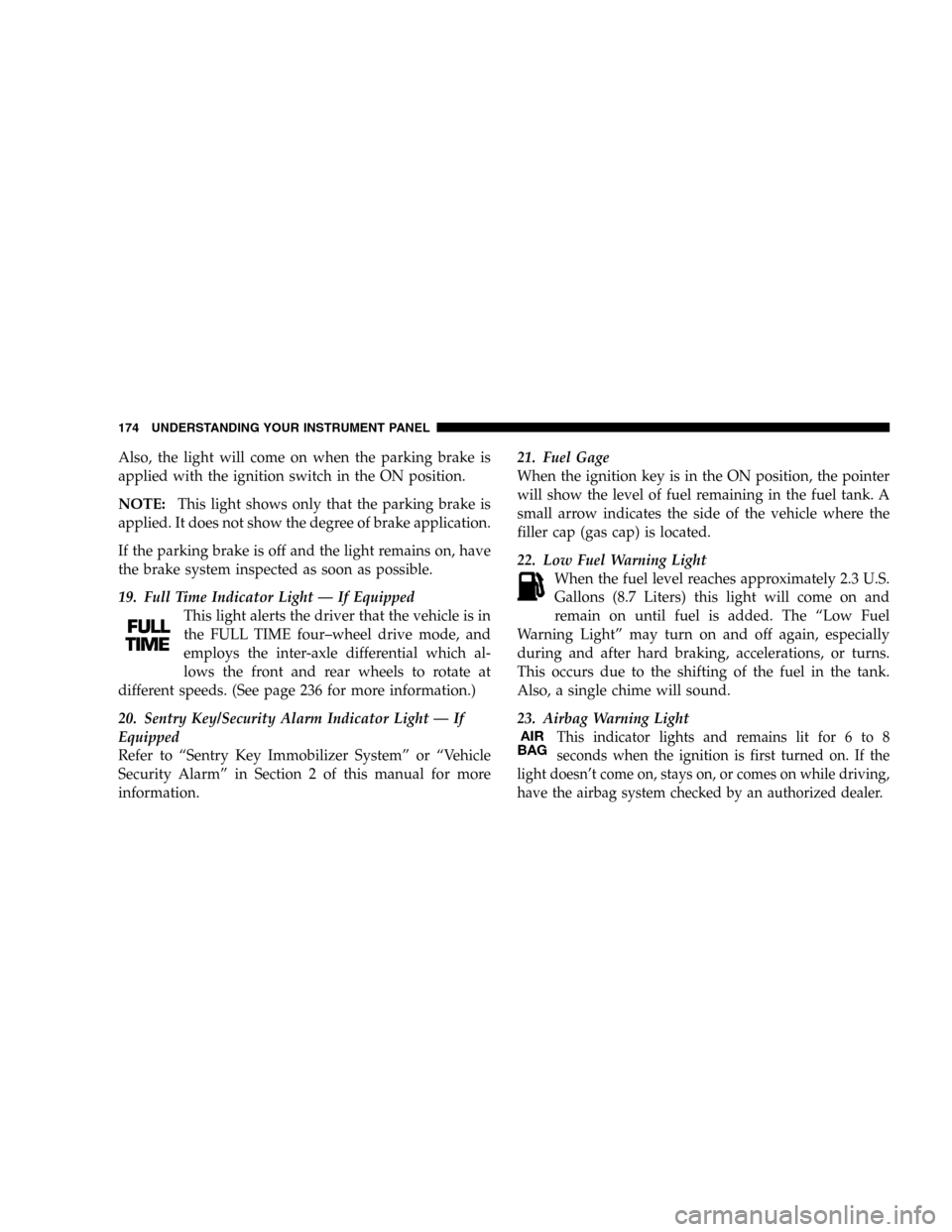
Also, the light will come on when the parking brake is
applied with the ignition switch in the ON position.
NOTE:This light shows only that the parking brake is
applied. It does not show the degree of brake application.
If the parking brake is off and the light remains on, have
the brake system inspected as soon as possible.
19. Full Time Indicator Light — If Equipped
This light alerts the driver that the vehicle is in
the FULL TIME four–wheel drive mode, and
employs the inter-axle differential which al-
lows the front and rear wheels to rotate at
different speeds. (See page 236 for more information.)
20. Sentry Key/Security Alarm Indicator Light — If
Equipped
Refer to “Sentry Key Immobilizer System” or “Vehicle
Security Alarm” in Section 2 of this manual for more
information.21. Fuel Gage
When the ignition key is in the ON position, the pointer
will show the level of fuel remaining in the fuel tank. A
small arrow indicates the side of the vehicle where the
filler cap (gas cap) is located.
22. Low Fuel Warning Light
When the fuel level reaches approximately 2.3 U.S.
Gallons (8.7 Liters) this light will come on and
remain on until fuel is added. The “Low Fuel
Warning Light” may turn on and off again, especially
during and after hard braking, accelerations, or turns.
This occurs due to the shifting of the fuel in the tank.
Also, a single chime will sound.
23. Airbag Warning Light
This indicator lights and remains lit for 6 to 8
seconds when the ignition is first turned on. If the
light doesn’t come on, stays on, or comes on while driving,
have the airbag system checked by an authorized dealer.
174 UNDERSTANDING YOUR INSTRUMENT PANEL
Page 177 of 424
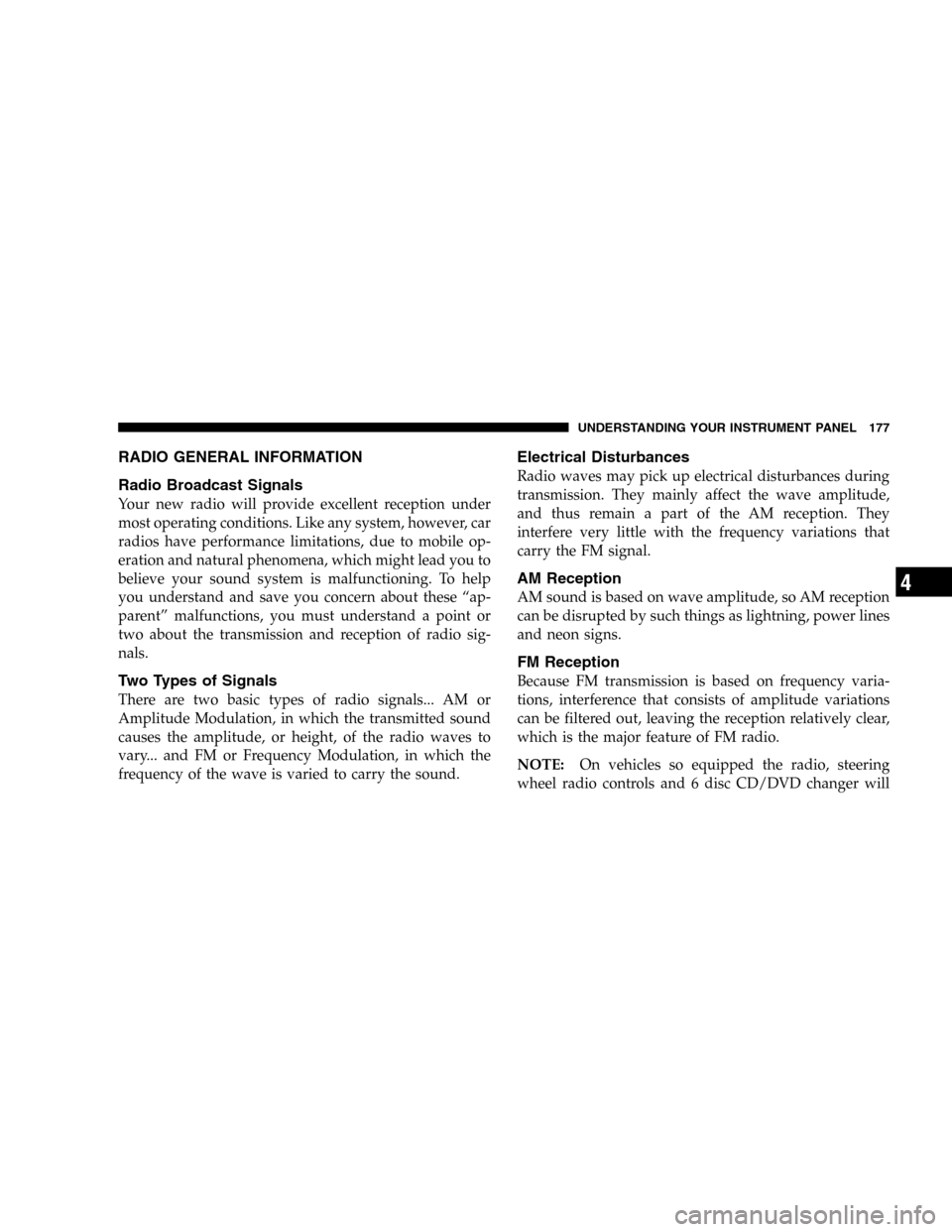
RADIO GENERAL INFORMATION
Radio Broadcast Signals
Your new radio will provide excellent reception under
most operating conditions. Like any system, however, car
radios have performance limitations, due to mobile op-
eration and natural phenomena, which might lead you to
believe your sound system is malfunctioning. To help
you understand and save you concern about these “ap-
parent” malfunctions, you must understand a point or
two about the transmission and reception of radio sig-
nals.
Two Types of Signals
There are two basic types of radio signals... AM or
Amplitude Modulation, in which the transmitted sound
causes the amplitude, or height, of the radio waves to
vary... and FM or Frequency Modulation, in which the
frequency of the wave is varied to carry the sound.
Electrical Disturbances
Radio waves may pick up electrical disturbances during
transmission. They mainly affect the wave amplitude,
and thus remain a part of the AM reception. They
interfere very little with the frequency variations that
carry the FM signal.
AM Reception
AM sound is based on wave amplitude, so AM reception
can be disrupted by such things as lightning, power lines
and neon signs.
FM Reception
Because FM transmission is based on frequency varia-
tions, interference that consists of amplitude variations
can be filtered out, leaving the reception relatively clear,
which is the major feature of FM radio.
NOTE:On vehicles so equipped the radio, steering
wheel radio controls and 6 disc CD/DVD changer will
UNDERSTANDING YOUR INSTRUMENT PANEL 177
4
Page 208 of 424
REMOTE SOUND SYSTEM CONTROLS — IF
EQUIPPED
The remote sound system controls are located on the rear
surface of the steering wheel. Reach behind the wheel to
access the switches.The right hand control is a rocker type switch with a
push-button in the center and controls the volume and
mode of the sound system. Pressing the top of the rocker
switch will increase the volume and pressing the bottom
of the rocker switch will decrease the volume.
Pressing the center button will make the radio switch
between the various modes available (AM/FM/TAPE/
CD, Etc.).
The left hand control is a rocker type switch with a
push-button in the center. The function of the left hand
control is different depending on which mode you are in.
The following describes the left hand control operation in
each mode.
208 UNDERSTANDING YOUR INSTRUMENT PANEL
Page 217 of 424
STARTING AND OPERATING
CONTENTS
�Starting Procedures.....................220
▫Manual Transmission..................220
▫Automatic Transmission................220
▫Normal Starting — Gasoline Engines.......221
▫Normal Starting — Diesel Engines.........223
▫Diesel Fuel-Water Separator..............225
▫Re-Priming The Diesel Fuel System........225
�Engine Block Heater — If Equipped.........226
�Transmission Shifting....................227▫6-Speed Manual Transmission............227
▫Automatic Transmission................230
▫Rocking The Vehicle...................236
�Four-Wheel Drive Operation...............236
▫Command-Trac�Operating
Information/Precautions................236
▫Shift Positions........................238
▫Shifting Procedure....................239
▫Selec-Trac�Operating Information/Precautions —
If Equipped.........................240
5
Page 229 of 424
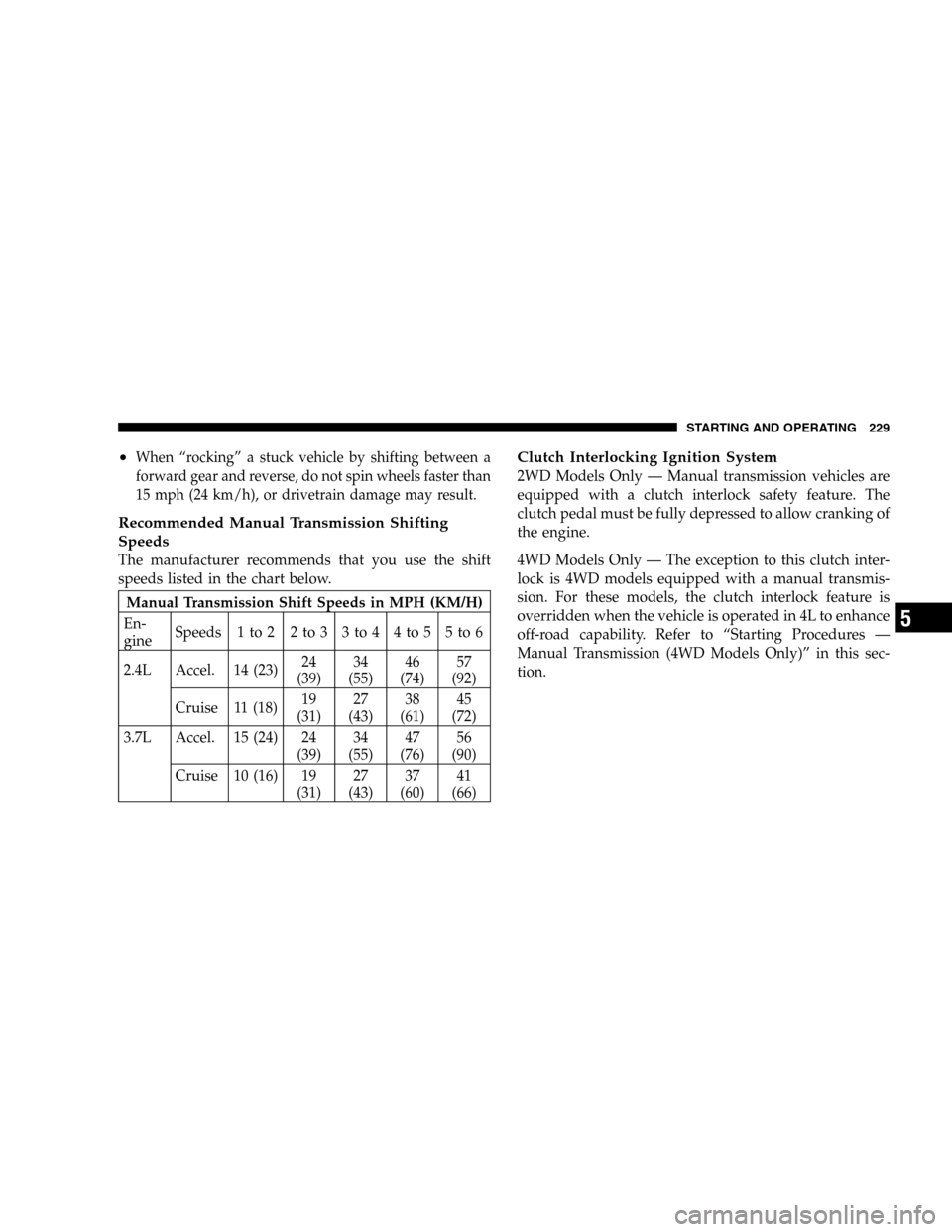
•When “rocking” a stuck vehicle by shifting between a
forward gear and reverse, do not spin wheels faster than
15 mph (24 km/h), or drivetrain damage may result.
Recommended Manual Transmission Shifting
Speeds
The manufacturer recommends that you use the shift
speeds listed in the chart below.
Manual Transmission Shift Speeds in MPH (KM/H)
En-
gineSpeeds 1 to 2 2 to 3 3 to 4 4 to 5 5 to 6
2.4L Accel. 14 (23)24
(39)34
(55)46
(74)57
(92)
Cruise 11 (18)19
(31)27
(43)38
(61)45
(72)
3.7L Accel. 15 (24) 24
(39)34
(55)47
(76)56
(90)
Cruise 10 (16) 19
(31)27
(43)37
(60)41
(66)
Clutch Interlocking Ignition System
2WD Models Only — Manual transmission vehicles are
equipped with a clutch interlock safety feature. The
clutch pedal must be fully depressed to allow cranking of
the engine.
4WD Models Only — The exception to this clutch inter-
lock is 4WD models equipped with a manual transmis-
sion. For these models, the clutch interlock feature is
overridden when the vehicle is operated in 4L to enhance
off-road capability. Refer to “Starting Procedures —
Manual Transmission (4WD Models Only)” in this sec-
tion.
STARTING AND OPERATING 229
5
Page 232 of 424
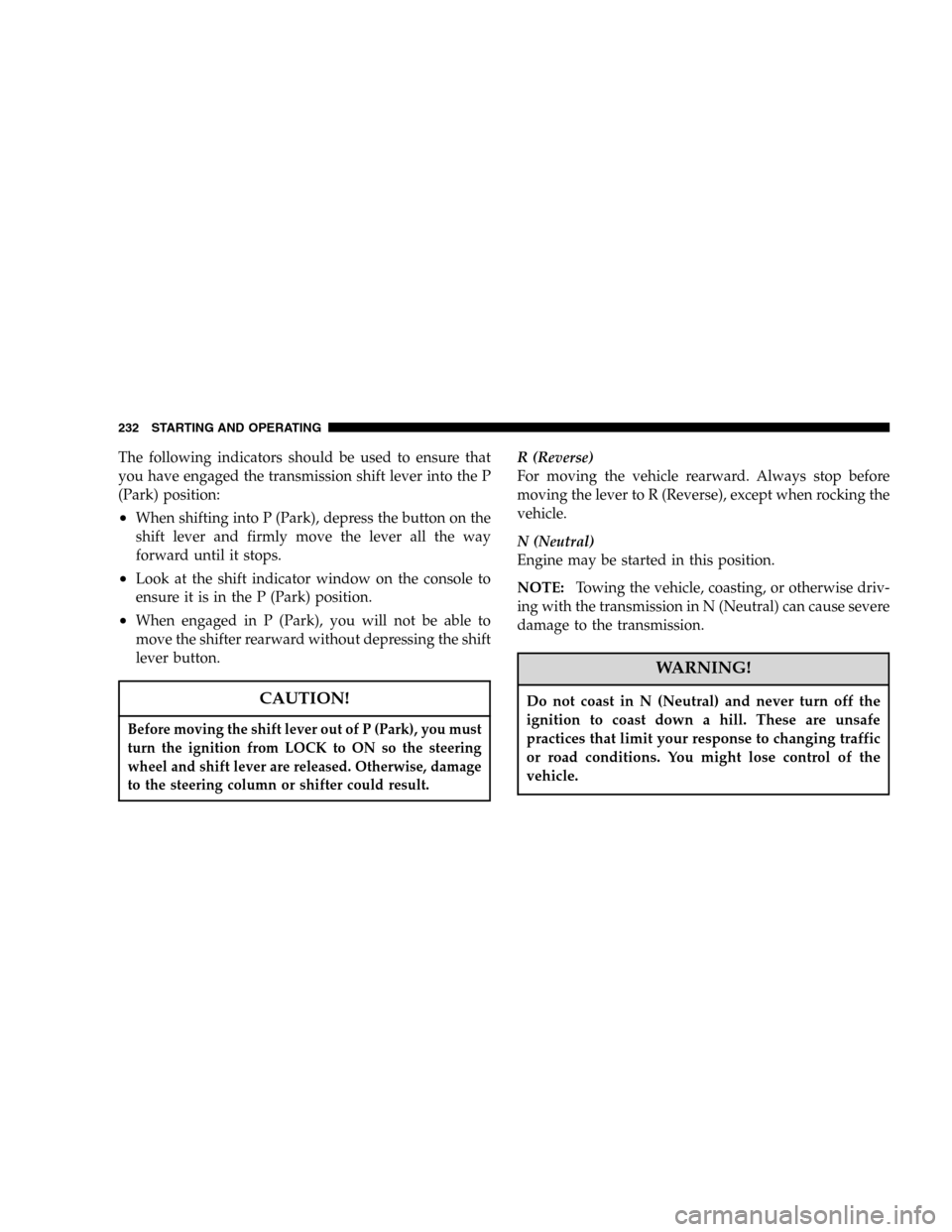
The following indicators should be used to ensure that
you have engaged the transmission shift lever into the P
(Park) position:
•When shifting into P (Park), depress the button on the
shift lever and firmly move the lever all the way
forward until it stops.
•Look at the shift indicator window on the console to
ensure it is in the P (Park) position.
•When engaged in P (Park), you will not be able to
move the shifter rearward without depressing the shift
lever button.
CAUTION!
Before moving the shift lever out of P (Park), you must
turn the ignition from LOCK to ON so the steering
wheel and shift lever are released. Otherwise, damage
to the steering column or shifter could result.
R (Reverse)
For moving the vehicle rearward. Always stop before
moving the lever to R (Reverse), except when rocking the
vehicle.
N (Neutral)
Engine may be started in this position.
NOTE:Towing the vehicle, coasting, or otherwise driv-
ing with the transmission in N (Neutral) can cause severe
damage to the transmission.
WARNING!
Do not coast in N (Neutral) and never turn off the
ignition to coast down a hill. These are unsafe
practices that limit your response to changing traffic
or road conditions. You might lose control of the
vehicle.
232 STARTING AND OPERATING
Page 234 of 424

NOTE:If the vehicle is started in cold outside tempera-
tures, shifts into Overdrive may be delayed. Normal
Overdrive and shifting operation will resume when the
temperature of the transmission reaches the appropriate
temperature. Refer to the “Note” under “Torque Con-
verter Clutch” later in this section.
If the transmission temperature gets too hot, the trans-
mission may downshift out of Overdrive or engage
overdrive at higher vehicle speeds until the transmission
cools down. After cooldown, Overdrive will resume
normal operation.
2 (Second)
For moderate grades and to assist braking on dry pave-
ment or in mud and snow. Begins at a stop in low gear
with automatic upshift to 2nd gear. Will not shift to 3rd.1 (First)
For hard pulling at low speeds in mud, sand, snow, or on
steep grades. Begins and stays in low gear with no upshift.
Provides engine compression braking at low speeds.
CAUTION!
•Never press on the accelerator pedal with the
engine running, vehicle in gear, and the brakes
applied. Always apply the brakes when stopped
on a incline. Failure to follow these instructions
can cause overheating and damage to the trans-
mission.
•When “rocking” a stuck vehicle by moving be-
tween “First” and R (Reverse), do not spin the
wheels faster than 15 mph (24 km/h), or drivetrain
damage may result.
234 STARTING AND OPERATING
Page 236 of 424
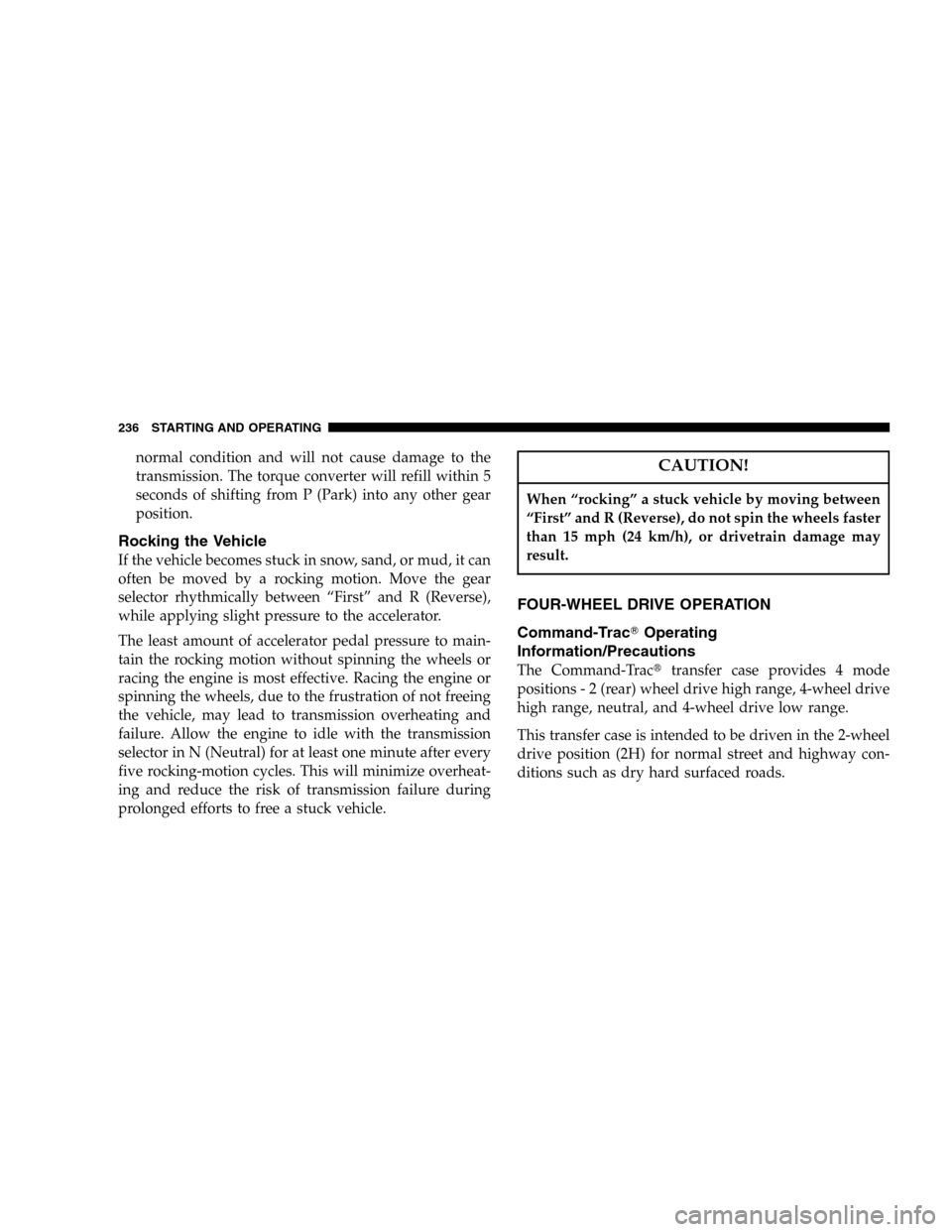
normal condition and will not cause damage to the
transmission. The torque converter will refill within 5
seconds of shifting from P (Park) into any other gear
position.
Rocking the Vehicle
If the vehicle becomes stuck in snow, sand, or mud, it can
often be moved by a rocking motion. Move the gear
selector rhythmically between “First” and R (Reverse),
while applying slight pressure to the accelerator.
The least amount of accelerator pedal pressure to main-
tain the rocking motion without spinning the wheels or
racing the engine is most effective. Racing the engine or
spinning the wheels, due to the frustration of not freeing
the vehicle, may lead to transmission overheating and
failure. Allow the engine to idle with the transmission
selector in N (Neutral) for at least one minute after every
five rocking-motion cycles. This will minimize overheat-
ing and reduce the risk of transmission failure during
prolonged efforts to free a stuck vehicle.
CAUTION!
When “rocking” a stuck vehicle by moving between
“First” and R (Reverse), do not spin the wheels faster
than 15 mph (24 km/h), or drivetrain damage may
result.
FOUR-WHEEL DRIVE OPERATION
Command-Trac�Operating
Information/Precautions
The Command-Trac�transfer case provides 4 mode
positions-2(rear) wheel drive high range, 4-wheel drive
high range, neutral, and 4-wheel drive low range.
This transfer case is intended to be driven in the 2-wheel
drive position (2H) for normal street and highway con-
ditions such as dry hard surfaced roads.
236 STARTING AND OPERATING